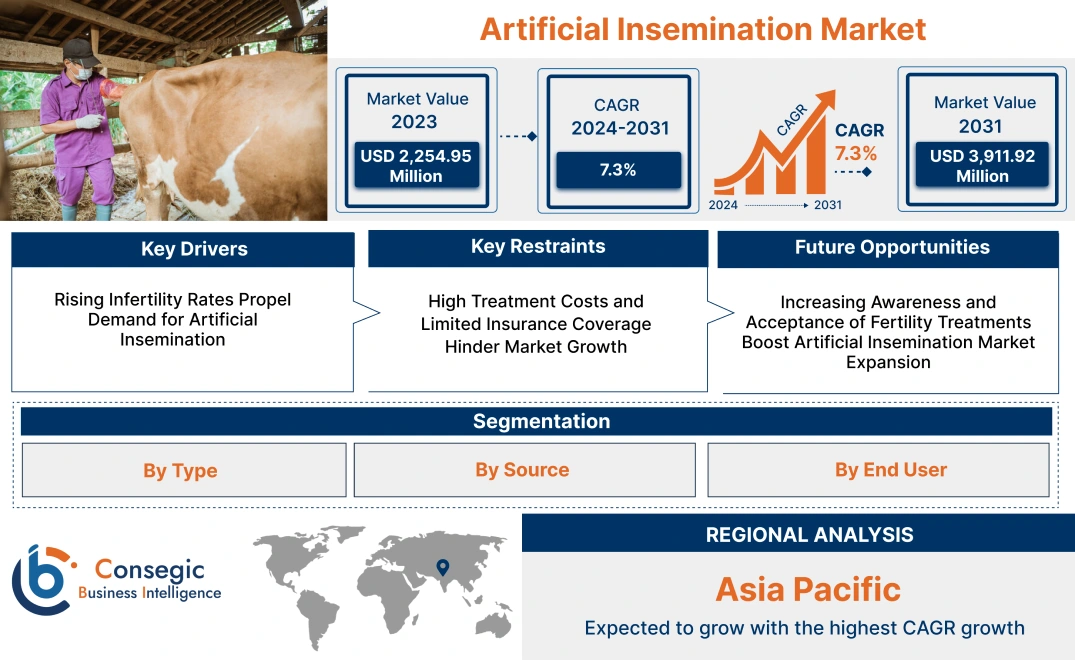- Summary
- Table Of Content
- Methodology
Artificial Insemination Market Size:
Artificial Insemination Market size is estimated to reach over USD 3,911.92 Million by 2031 from a value of USD 2,254.95 Million in 2023 and is projected to grow by USD 2,394.50 Million in 2024, growing at a CAGR of 7.3% from 2024 to 2031.
Artificial Insemination Market Scope & Overview:
The artificial insemination market involves the process of directly inserting sperm into a woman's reproductive tract to assist in conception. This technique is widely used in human fertility treatments and animal breeding programs. Artificial insemination methods include intrauterine insemination (IUI), intracervical insemination (ICI), and intratubal insemination (ITI), each catering to specific fertility challenges. Key features of artificial insemination include enhanced control over-fertilization, minimized handling of gametes, and improved success rates for certain infertility cases. Benefits include its non-invasive nature, lower cost compared to in vitro fertilization (IVF), and higher accessibility for couples facing infertility. The applications span fertility clinics, livestock breeding, and veterinary services, serving end-users like hospitals, specialized fertility clinics, and animal breeding facilities.
Artificial Insemination Market Dynamics - (DRO) :
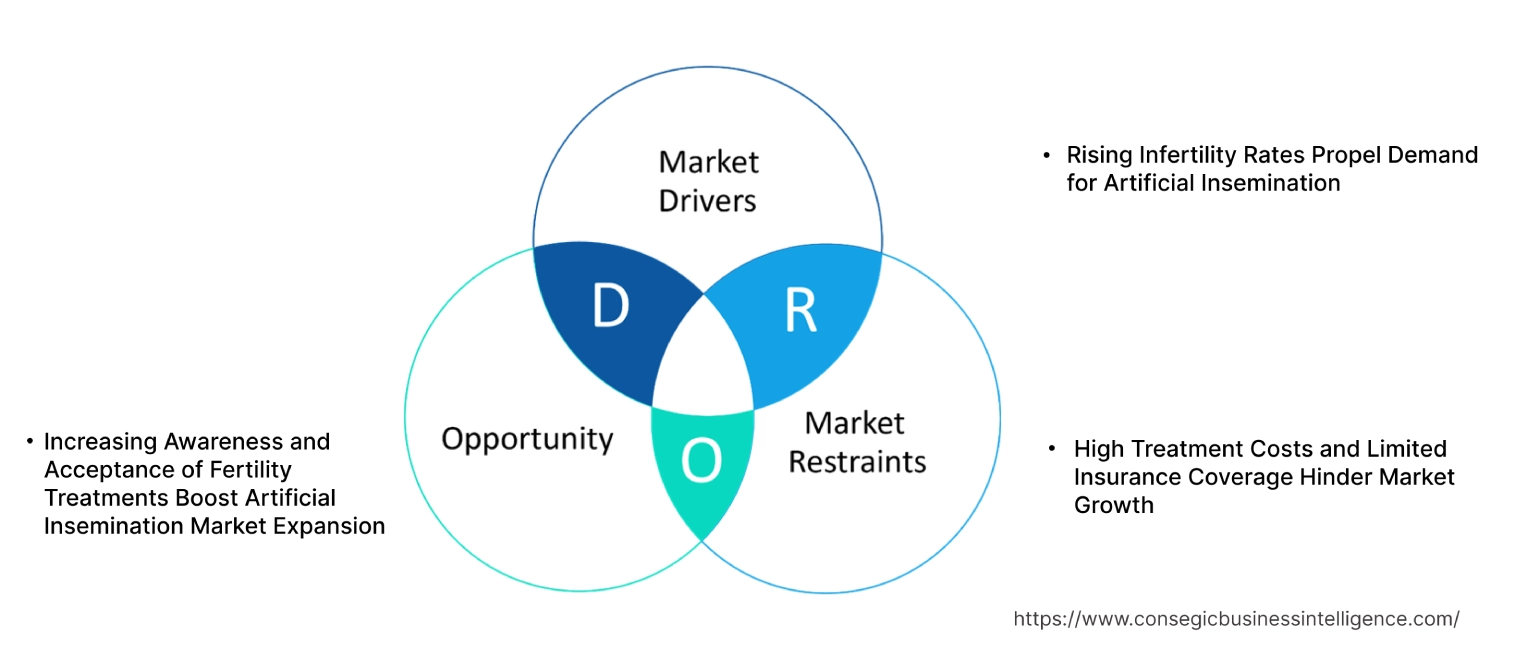
Key Drivers:
Rising Infertility Rates Propel Demand for Artificial Insemination
The increasing prevalence of infertility worldwide is a key driver for the growth of the artificial insemination market opportunity. Factors such as changing lifestyle habits, rising maternal age, and exposure to environmental toxins are contributing to declining fertility rates in both men and women. As more couples face difficulties conceiving naturally, artificial insemination has become a widely accepted and cost-effective fertility treatment option. This technique offers higher success rates for couples dealing with conditions like low sperm count or unexplained infertility, enhancing its adoption in fertility clinics and hospitals globally.
Key Restraints :
High Treatment Costs and Limited Insurance Coverage Hinder Market Growth
The high cost of artificial insemination procedures is a significant barrier to market development. Artificial insemination often involves multiple cycles of treatment, including consultations, hormone therapy, and sperm preparation, which can increase the overall cost for patients. This financial burden is exacerbated by the fact that many health insurance plans do not cover fertility treatments or only offer limited coverage, leaving a majority of patients to pay out of pocket.
Furthermore, the lack of comprehensive insurance coverage for fertility treatments is particularly challenging in developing countries, where disposable income is lower, and access to specialized fertility care is limited. Even in developed regions, the out-of-pocket expenses deter many individuals and couples from pursuing artificial insemination, restricting the potential patient pool. As a result, the market faces constraints in reaching its full growth potential, especially among lower-income groups and uninsured patients.
Future Opportunities :
Increasing Awareness and Acceptance of Fertility Treatments Boost Artificial Insemination Market Expansion
Growing awareness and acceptance of fertility treatments present a significant opportunity for the artificial insemination market trend. Public awareness campaigns, educational programs, and advancements in medical technology have contributed to reducing the stigma associated with fertility treatments. As societal attitudes shift, more individuals and couples are seeking professional help for conception, leading to higher demand for artificial insemination procedures. This trend is creating global awareness for healthcare providers to expand their services and for companies to develop innovative solutions that enhance treatment outcomes.
Artificial Insemination Market Segmental Analysis :
By Type:
Based on type, the market is segmented into Intrauterine Insemination (IUI), Intracervical Insemination (ICI), Intravaginal Insemination (IVI), and Intratubal Insemination.
The Intrauterine Insemination (IUI) segment accounted for the largest revenue of the total artificial insemination market share in 2023.
- Intrauterine Insemination (IUI) is the most commonly used type of artificial insemination, widely adopted due to its higher success rates and less invasive nature.
- During this procedure, sperm is directly introduced into a woman's uterus, bypassing the cervix.
- This method places the sperm closer to the egg, significantly increasing the chances of fertilization.
- IUI is typically recommended for couples dealing with mild male infertility, unexplained infertility, or cervical issues that hinder sperm movement.
- The procedure can be performed during a natural ovulation cycle or following ovarian stimulation with fertility medications.
- IUI is cost-effective compared to more advanced techniques like in vitro fertilization (IVF), making it a preferred initial treatment.
- Due to its simplicity, reduced discomfort, and relatively higher pregnancy rates, IUI remains a favored choice among fertility specialists and patients, contributing significantly to the overall industry of artificial insemination market growth.
The Intracervical Insemination (ICI) segment is anticipated to register the fastest share CAGR during the forecast period.
- Intracervical Insemination (ICI) involves placing sperm into the cervix, closer to the uterus.
- It is a less invasive and simpler procedure compared to IUI, often performed in clinical settings or at home using insemination kits.
- ICI is typically chosen by couples looking for a less costly and more straightforward approach to conception, especially when sperm quality is sufficient, but timing or mild cervical issues impact natural conception.
- The technique does not require ovarian stimulation, making it less intensive.
- However, ICI generally has a lower success rate than IUI because it does not place sperm as close to the egg.
- Despite this, ICI remains a popular choice for its affordability, minimal discomfort, and privacy, particularly among individuals preferring at-home procedures.
- It is also commonly used in cases of donor insemination, providing a simpler option for conception without extensive medical intervention.
- Hence, the segmental analysis shows a significant rise in the artificial insemination market industry by making it less intensive, home-procedure, and non-extensive medication.
By Source:
Based on by source the market is segmented into Artificial Insemination by Husband (AIH) and Artificial Insemination by Donor (AID).
The artificial insemination by husband (AIH) segment accounted for the largest revenue of 58.85% of the total artificial insemination market share in 2023.
- Artificial Insemination by Husband (AIH) uses sperm from the male partner, typically chosen when couples prefer to maintain a genetic link with both parents.
- AIH is recommended in cases where the male partner has mild fertility issues, such as low sperm count or reduced motility, but the sperm quality is sufficient after processing.
- In this procedure, sperm undergoes preparation techniques, such as washing and concentration, to enhance its viability before insemination.
- AIH is widely utilized in conditions like unexplained infertility, cervical factor infertility, or when sexual dysfunction impacts natural conception.
- The procedure is minimally invasive and cost-effective, often carried out through intrauterine insemination (IUI) for better results.
- The increasing prevalence of mild male infertility and the rising awareness of fertility treatment options have contributed to the steady expansion of AIH share in the market, making it a preferred choice for many couples seeking assisted reproductive solutions.
Artificial Insemination by Donor (AID) segment is anticipated to register the fastest CAGR during the forecast period.
- Artificial Insemination by Donor (AID) involves the use of donor sperm, which is a vital option for couples facing severe male infertility, or genetic disorders, or for single women and same-sex couples wishing to conceive.
- The donor sperm used in AIDS undergoes rigorous screening for genetic health, sexually transmitted infections, and quality parameters, ensuring its safety and viability for use.
- AID is often recommended when the male partner has azoospermia (no sperm production) or carries inheritable genetic conditions that may affect the child's health.
- It is also a growing choice for individuals opting for single parenthood or LGBTQ+ couples seeking family expansion.
- With the increased availability of sperm banks and the advancements in cryopreservation technology, donor sperm can be stored and used effectively, even after years of freezing.
- The rising social acceptance of donor insemination, coupled with better access to quality donor sperm, has propelled the demand for AIDS.
- The segment analysis shows continuous evolvement and rising trend, as more couples and individuals turn to this method for achieving pregnancy, benefiting from the comprehensive screening and high success rates associated with donor insemination procedures.
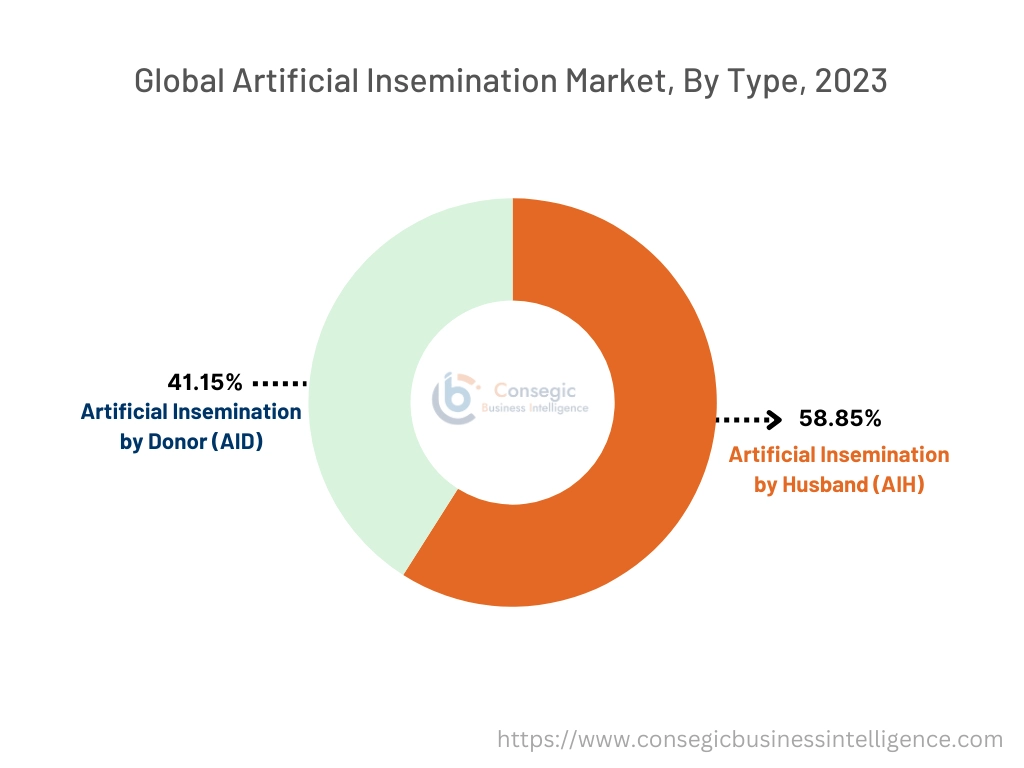
By End-User:
Based on end users the market is segmented into Fertility Clinics, Hospitals and Clinics, and Home-Based Settings.
Fertility Clinics segment accounted for the largest revenue share of the total artificial insemination market in 2023
- Fertility clinics are the largest share and most significant end-users in the artificial insemination market, providing specialized reproductive services and tailored treatment plans.
- These clinics employ advanced technologies and trained specialists, offering comprehensive solutions like Intrauterine Insemination (IUI) and Intracervical Insemination (ICI), which cater to different patient needs.
- Fertility clinics are equipped with sophisticated diagnostic tools and laboratory facilities, ensuring high success rates through meticulous sperm preparation, timing of insemination, and precise monitoring of ovulation cycles.
- With increasing infertility rates and a growing demand for assisted reproductive technologies (ART), these clinics are expanding their services, adopting newer techniques, and investing in state-of-the-art equipment to improve patient outcomes.
- Their focus on personalized care and the availability of diverse fertility treatments make them a preferred choice for couples and individuals seeking reproductive assistance.
Hospitals and Clinics segment is anticipated to register the fastest CAGR during the forecast period.
- Hospitals and general healthcare clinics play a crucial role in the artificial insemination market by integrating insemination procedures into their broader reproductive health services.
- These settings are more accessible than specialized fertility clinics, offering artificial insemination as part of comprehensive gynecological and obstetric care.
- Hospitals typically cater to a wide range of patients, including those with complex medical histories or co-existing health conditions that may impact fertility.
- They often have dedicated departments for reproductive health, supported by experienced medical staff capable of handling various insemination procedures like IUI and ICI.
- Moreover, hospitals are well-equipped to manage any potential complications during the procedure, ensuring patient safety.
- As demand for infertility treatments rises, many hospitals are expanding their reproductive services, implementing specialized programs, and collaborating with fertility experts to provide a holistic approach to patient care.
Regional Analysis:
The regions covered are North America, Europe, Asia Pacific, the Middle East and Africa, and Latin America.
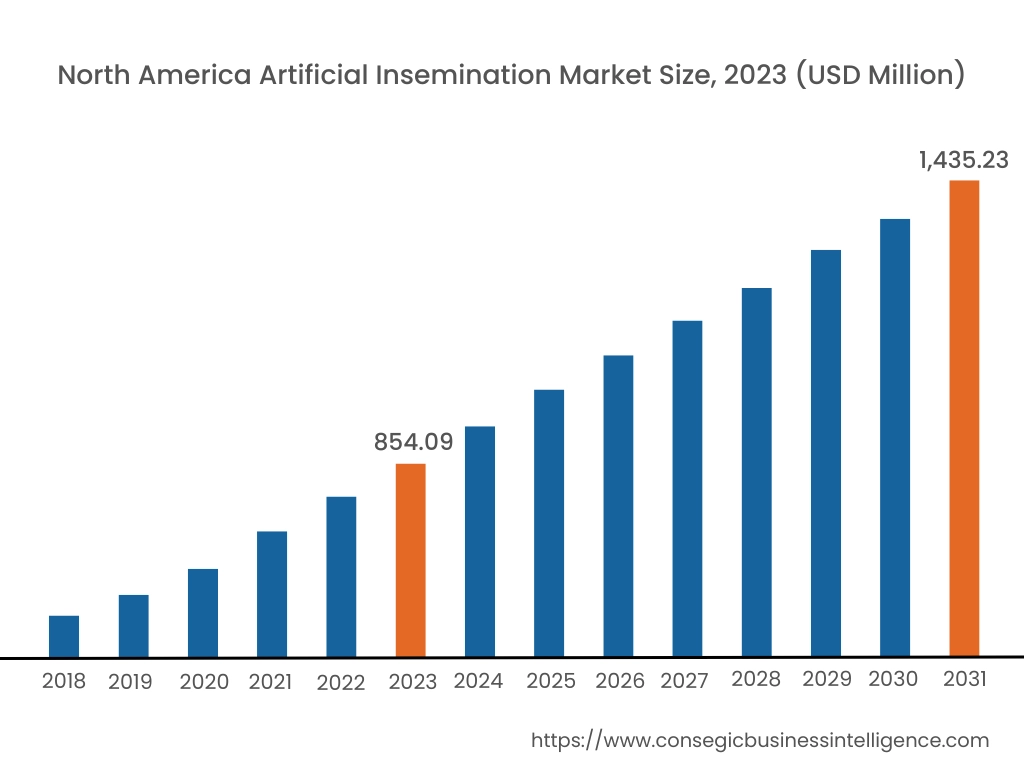
North America is estimated to reach over USD 1,435.23 Million by 2031 from a value of USD 854.09 Million in 2023 and is projected to grow by USD 903.48 Million in 2024. Out of which, the U.S. accounted for the largest share of 70.30 in 2023. The artificial insemination market in North America is driven by advanced healthcare infrastructure, high awareness of fertility treatments, and a large number of fertility clinics. The growing trend of delayed parenthood and increasing fertility issues are major factors contributing to market growth. Government initiatives and insurance coverage for fertility treatments further support the market.
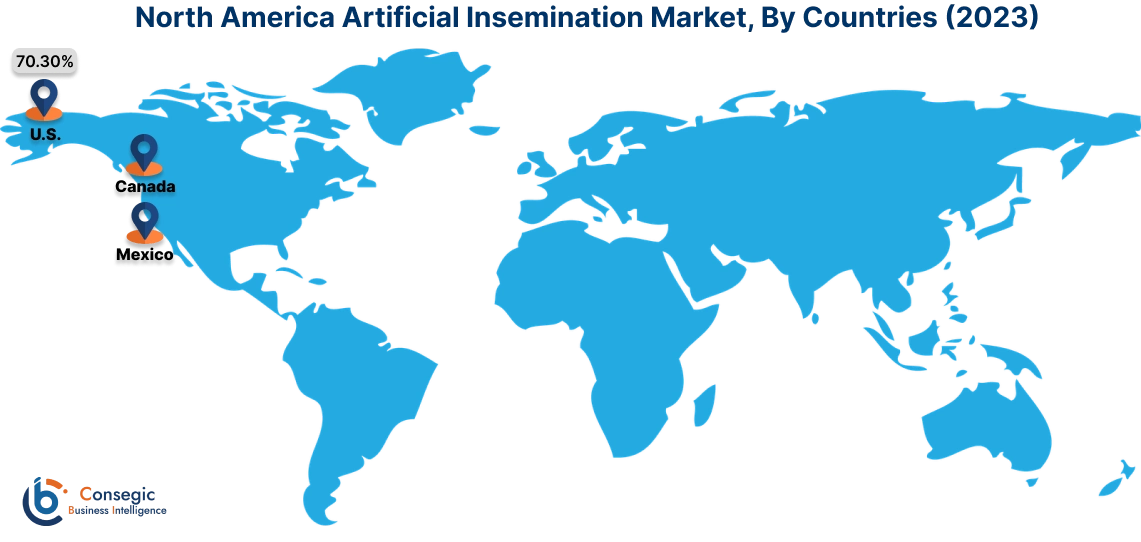
Asia Pacific region was valued at USD 565.07 Million in 2023. Moreover, it is projected to grow by USD 603.04 Million in 2024 and reach over USD 1,020.20 Million by 2031. The market in the Asia-Pacific region is expanding rapidly due to rising healthcare accessibility and improving fertility treatment awareness. Countries like India and China are seeing increased artificial insemination market demand for artificial insemination services as a result of urbanization, rising disposable incomes, and evolving societal norms surrounding family planning and childbearing..
Europe remains a key player in the artificial insemination market, bolstered by widespread healthcare access, advanced reproductive technologies, and high awareness levels. Fertility preservation practices are on the rise, particularly in countries like Germany, the UK, and France, where fertility clinics are increasingly in demand. Legal frameworks analysis and regulations around artificial insemination vary, influencing market growth.
In the Middle East and Africa, the market trend is experiencing growth due to improving healthcare systems and an increasing focus on addressing infertility challenges. Socio-cultural shifts, particularly in the UAE and Saudi Arabia, are driving opportunities for fertility treatments. However, analysis shows regulatory hurdles and cultural factors remain obstacles in certain regions.
The analysis depicts the artificial insemination market in Latin America as a growing trend due to expanding access to fertility services, particularly in countries like Brazil and Mexico. The rise in awareness about infertility treatments and improving economic conditions are contributing factors. However, variations in healthcare accessibility across the region can affect the market's overall performance.
Top Key Players & Market Share Insights:
The artificial insemination market is highly competitive with major players providing products and services to the national and international markets. Key players are adopting several strategies in research and development (R&D), product innovation, and end-user launches to hold a strong position in the global artificial insemination market. Key players in the artificial insemination industry include -
- Vitrolife (Sweden)
- Fujifilm Irvine Scientific (United States)
- Genea Ltd. (Australia)
- Pride Angel Ltd. (United Kingdom)
- Rocket Medical plc (United Kingdom)
- Conceivex, Inc. (United States)
- Hamilton Thorne, Inc. (United States)
- Kitazato Corporation (Japan)
- Biogenics Inc. (United States)
- Surelife Pte Ltd. (Singapore)
Recent Industry Developments :
- In June 2022, FUJIFILM Irvine Scientific, Inc., a leader in cell culture media and assisted reproductive technologies (ART), announced the exclusive licensing of intellectual property for AI-driven image analysis of human embryos to enhance IVF success rates. The technology, developed and patented by researchers from Brigham and Women's Hospital and Massachusetts General Hospital, combines expertise in AI, biomedical engineering, and IVF. Financial terms of the agreement were not disclosed.
Artificial Insemination Market Report Insights :
| Report Attributes | Report Details |
| Study Timeline | 2018-2031 |
| Market Size in 2031 | USD 3,911.92 Million |
| CAGR (2024-2031) | 7.3% |
| By Type |
|
| By Source |
|
| By End User |
|
| By Region |
|
| Key Players |
|
| North America | U.S. Canada Mexico |
| Europe | U.K. Germany France Spain Italy Russia Benelux Rest of Europe |
| APAC | China South Korea Japan India Australia ASEAN Rest of Asia-Pacific |
| Middle East and Africa | GCC Turkey South Africa Rest of MEA |
| LATAM | Brazil Argentina Chile Rest of LATAM |
| Report Coverage |
|
Key Questions Answered in the Report
How big is the artificial insemination market? +
The Artificial Insemination Market size is estimated to reach over USD 3,911.92 Million by 2031 from a value of USD 2,254.95 Million in 2023 and is projected to grow by USD 2,394.50 Million in 2024, growing at a CAGR of 7.3% from 2024 to 2031.
What are the types of artificial insemination techniques? +
The main techniques include intrauterine insemination (IUI) and intracervical insemination (ICI), with IUI being the more commonly used method.
What factors are driving the artificial insemination market growth? +
Factors include increasing infertility rates, advancements in reproductive technology, rising awareness, and social acceptance of assisted reproductive techniques.
Which regions are leading the artificial insemination market? +
North America and Europe lead the market due to advanced healthcare systems, higher fertility awareness, and strong regulatory frameworks.
